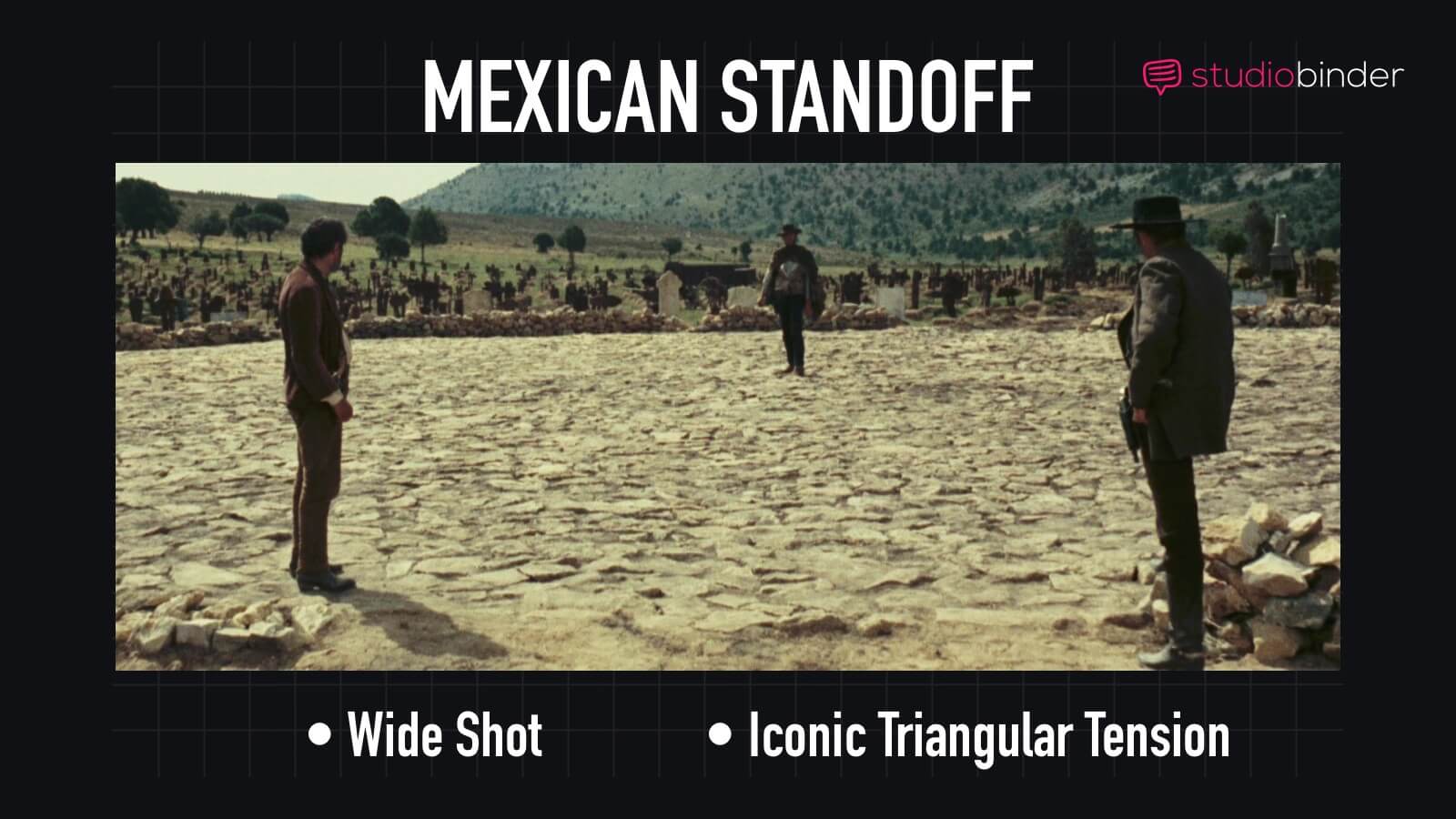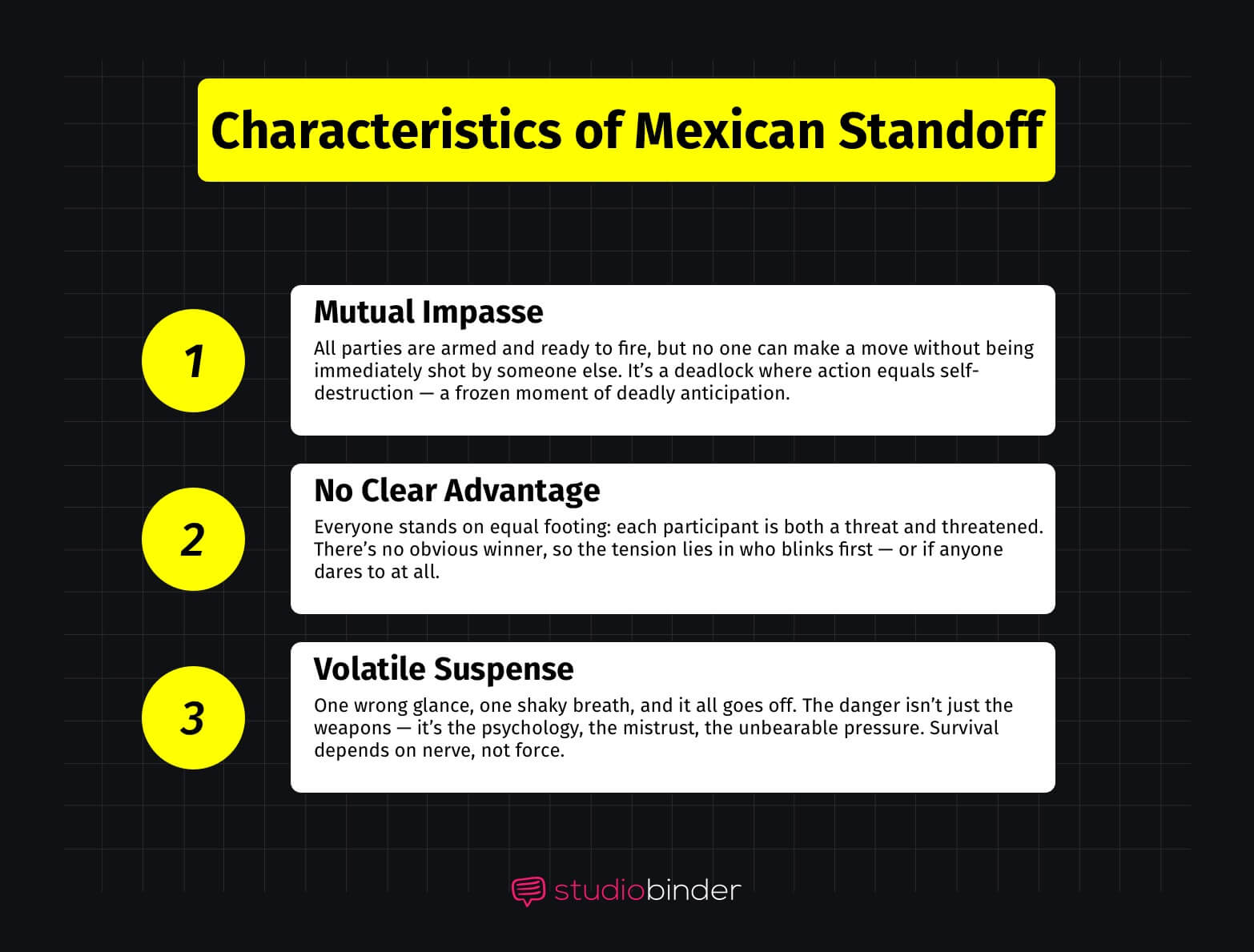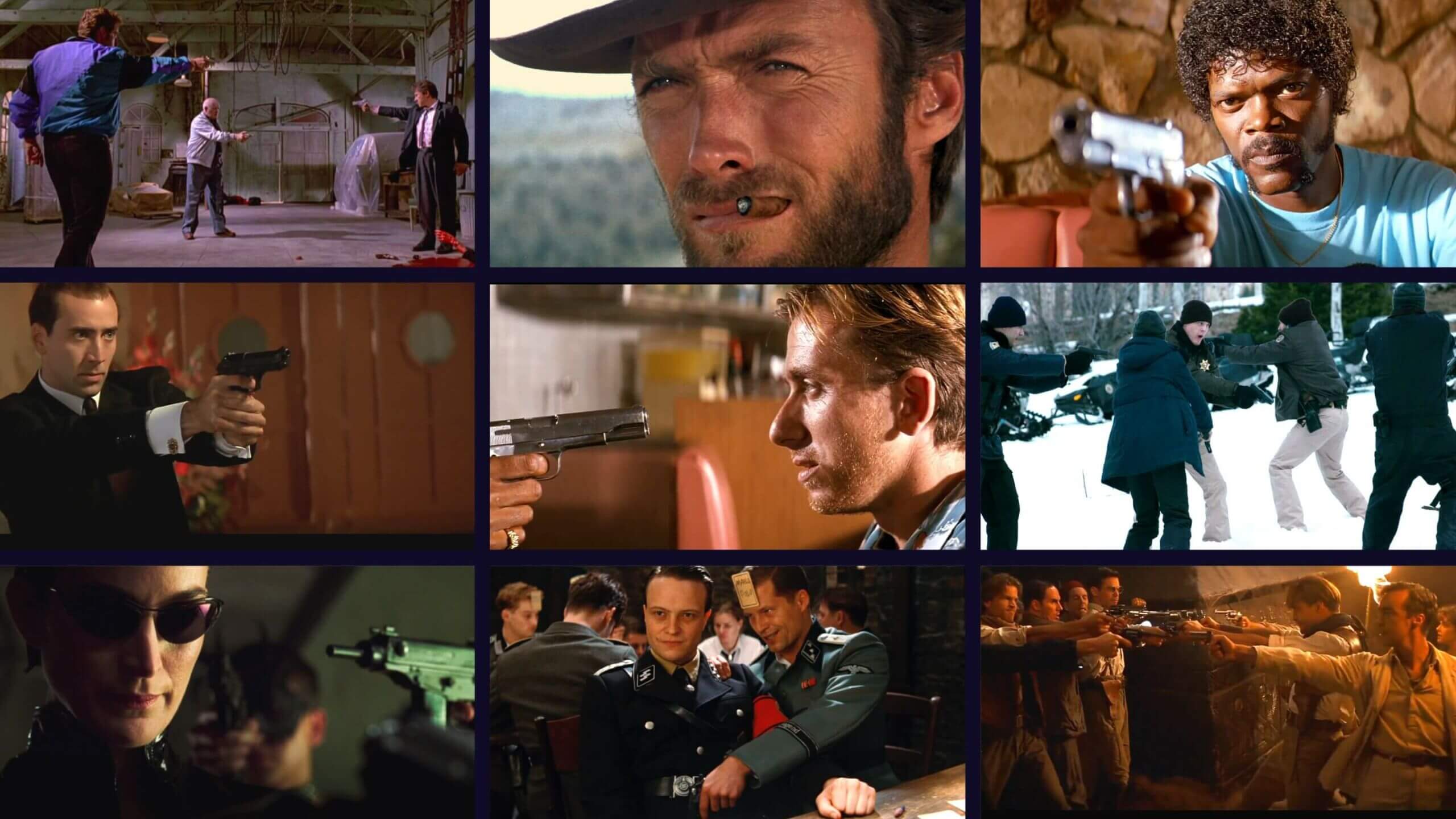What is a Mexican Standoff? And for that matter, how does it differ from a regular standoff? In this post, we’ll be digging into the term, breaking down its origins, clearing up common misconceptions, and taking a look at some of the best examples. We’ll also be answering the question: why is it called a Mexican Standoff? And, be sure to watch our video essay below for a guide on shooting and editing Mexican Standoff scenes.
Mexican standoff origin
Let’s define Mexican Standoff
As we get started with our Mexican Standoff definition, keep our ultimate guides to screenwriting vocabulary and cinematography terms in mind. Both will be helpful resources if you decide to write or shoot one yourself.
MEXICAN STANDOFF DEFINITION
What is a Mexican Standoff?
A Mexican Standoff is a violent confrontation between two or more people in which no party can easily best the other(s) and walk away unscathed. In these situations, an act of aggression directly triggers a corresponding act upon the aggressor. Death or serious harm is guaranteed for all parties involved. Adversaries pointing guns at each other is commonly linked to this trope, though other weapons may be used instead.
The term "Mexican Standoff" originated as a term in a short story by F. Harvey Smith from 1876. “We will call it a stand-off, a Mexican Standoff, you lose your money, but you save your life!” As you can tell from that quote, how we understand the term today is quite different.
Mexican Standoff Meaning
- A violent confrontation between two or more parties
- No party holds a clear advantage
- Everyone involved is at risk of injury or worse
Mexican standoff origin
Standoff vs. Mexican Standoff
In common parlance, the terms “standoff” and “Mexican Standoff” are often used interchangeably, but there is one clear distinction between the two types of confrontations. One party can hold a clear advantage in a standoff, while all parties in a Mexican Standoff share the same level of risk and danger.
In other words, someone can walk away victorious if a standoff erupts into outright violence, but if a Mexican Standoff boils over into outright violence, nobody is walking away unharmed.

What is a Mexican Standoff • Mexican Standoff Example in The Good The Bad and the Ugly
This distinction most commonly manifests as the weapons being holstered in a standoff vs. drawn and aimed in a Mexican Standoff. This scene from spaghetti western The Good, The Bad and The Ugly is the textbook example of a traditional standoff. Clint Eastwood’s Man with No Name is able to best his opposition in a contest of speed and skill.
The Good, the Bad and the Ugly standoff scene
By contrast, the following scene is an example of a Mexican Standoff. Technically, there are really two different Mexican Standoffs in a row in this clip — first as they aim guns under the table and then during the aftermath.
Why is it called a Mexican standoff? • Inglourious Basterds example
As opposed to the first scene, this example from Inglourious Basterds is far messier and bloodier. As a result, the bodycount and level of chaos are much higher. A sense of mutually-assured destruction is shared by all of the parties involved. The exception here is Bridget von Hammersmark as she is a bit of a wildcard that throws a wrench into the proceedings. To see how this sequence was written, check out our Inglourious Basterds script breakdown.
Related Posts
Mexican standoff synonym
How to shoot a Mexican Standoff
There are more ways to shoot and edit a Mexican Standoff than you might realize. As long as you include the main ingredients, as we’ve covered above, then there is no incorrect way to execute this type of sequence.
However, there are a handful of elements that every great maestro takes into consideration when preparing their scene.
Begin in pre-production at the writing level and flesh out what sets your scenario apart from other takes on this trope. You can switch up elements such as the number of combatants, the weapons used, or any other variables you would like to throw into the mix.
Then comes principal photography. Will you use static or dynamic camera movement? Or perhaps a mix of both. Some takes on this trope play out entirely in wide shots, while other examples mix in plenty of mediums and close-ups. Figure out the shot sizes and composition that best fit your scene.
StudioBinder’s Guide to Shot Sizes • Subscribe on YouTube
Post-production provides you with yet another opportunity to shape your standoff. Within the edit, you can set the pace of your sequence and nail down the tone, whether it be stylized or realistic. All three phases of production play a part in shaping the final scene.
Related Posts
Mexican standoff meaning
Mexican Standoff examples
While certainly not the first director to put this type of standoff into his films, John Woo is widely credited with popularizing the trope throughout Hong Kong action cinema. He has packed many of his films with dynamic interpretations of this trope.
In the video below, you can see a supercut with just some of his best Mexican Standoff scenes alongside his other directorial trademarks.
John Woo trademarks • What is Mexican standoff
Over in the west, a different director is more closely linked to this trope: Quentin Tarantino. John Woo’s films had a large influence on Tarantino, so it only makes sense that he would pack his own films with compelling Mexican Standoffs as well. Tarantino’s filmography offers no shortage.
We’ve already taken a look at examples from Inglorious Basterds above and Reservoir Dogs in our video, but we can also find exciting examples in True Romance, Natural Born Killers, Kill Bill, and this scene from Pulp Fiction.
Pulp Fiction Mexican standoff example
For more Pulp Fiction goodness, you can check out our breakdown of the iconic dance scene or grab a PDF download of the Pulp Fiction script. For more Tarantino examples, be sure to check out our list ranking of Quentin Tarantino’s filmography.
But, this trope is by no means confined to just a handful of directors; it can be found all across the cinematic spectrum. For a comedic take on the trope, look no further than Seven Psychopaths.
Seven Psychopaths Mexican standoff scene
And lastly, this scene from the action-thriller A Bittersweet Life — one of the best South Korean movies. This scene offers a literal deconstruction of the trope. By placing two armed parties in close proximity but having both of their guns disassembled, this scene becomes a race to put their guns back together and fire first.
This effectively bridges the gap between a traditional standoff where skill and speed are involved and a Mexican Standoff where the combatants are already pointing their guns at each other, and the threat of death is imminent.
A Bittersweet Life Mexican standoff example
The Mexican Standoff might be a trope built out of a handful of rules, but those rules can be stretched before breaking. Get creative with the Mexican Standoffs in your own projects.

What is a Mexican Standoff • Characteristics of Mexican Standoff
Related Posts
UP NEXT
What is a Trope?
You should now have a pretty good handle on what a Mexican Standoff is, but if calling this type of scene a trope throughout this post confused you, it might be the perfect time to learn what a trope is and take a look at some examples. Learn everything you need to know about tropes, up next.
Up Next: What is a Trope? →
Share your vision with elegant shot lists and storyboards.
Create robust and customizable shot lists. Upload images to make storyboards and slideshows.
